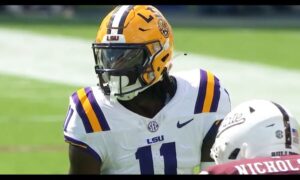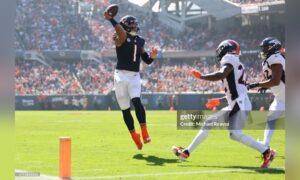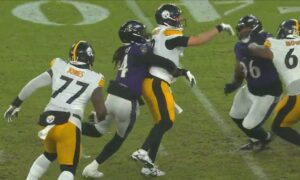By Dave-Te Thomas, The NFL Draft Report Editor
As of Friday, the league had ninety-eight underclassmen confident in their ability to play at the next level. That list does not include four other underclassmen that have already graduated ahead of schedule. Like most of the recent drafts, scouts are anticipating that a good portion of these athletes will be in for a huge disappointment when their names are not called on draft day.
The high amount of “not ready for prime time” athletes has raised serious concerns for scouting directors and general managers throughout the league. Yet, the NFL has only itself to blame for the recent influx of talent bolting the collegiate ranks for greener pastures. In 2011, the new collective bargaining agreement greatly limited the amount of money a rookie would receive in his initial pro contract, as wage scale limits prevented teams from doling out big bucks for untested talent.
During the 2011 draft, fifty-six players with college eligibility left their respective teams with hopes for playing in the NFL. Forty-three of those early entrants were drafted (76.79%), with Auburn quarterback Cam Newton making it the third consecutive year that an underclassmen was selected with the first choice.
Since non-seniors were first eligible to be drafted in 1990, fifteen first overall picks (including seven of the last eight drafts) had been players who entered the draft early. Eight of the first ten players chosen in the 2011 draft were non – seniors, which broke the record of six set in 1997 and matched in 2006. Defensive rush end/linebacker Von Miller of Texas A&M (second selection by Denver) and quarterback Jake Locker of Washington (eighth pick by Tennessee) were the only two seniors among the first ten draftees that year.
A total of fifteen underclassmen in the 2011 draft heard their names called in the first round. Eleven more were taken in round two, followed by five that went in the third round, including New England using back-to-back picks for a pair of Southeastern Conference performers in tailback Stevan Ridley (LSU) and quarterback Ryan Mallett (Arkansas).
The only notable performer among underclassmen to be selected after the 2011 second round was Kansas City using the 70th pick for linebacker Justin Houston. Rounds Four-through-Seven produced nine more underclass selections, but to date, none of those athletes have been anything more than depth on the roster chart.
The following year, the league saw a then-record sixty-five underclassmen announce their intention to forgo their remaining NCAA eligibility and become eligible to be selected in the draft. Of those 65 eligible underclassmen, forty-four (67.69%) were drafted. When the Indianapolis Colts chose Stanford quarterback Andrew Luck, it marked the fourth-straight year where the first overall selection was an underclassman.
Eight of the first ten players chosen in that draft were non-seniors, which matched the record set in the previous draft. Alabama safety Mark Barron (seventh choice by Tampa Bay) and Texas A&M quarterback Ryan Tannehill (eighth selection by Miami) were the only two seniors among the first ten draftees in 2012. A total of fifteen underclassmen went in the opening round, followed by eight more in round two.
The third round saw seven more hear their names called, not including Ohio State’s Terrelle Pryor, who was taken by the Raiders during the supplemental draft, forfeiting their choice in the regular phase of that round for making that selection. Miami might have unearthed a “blue-collar” ball carrier when they took Lamar Miller in Round Four, as the running back was one of five underclassmen taken in that round. Rounds Five-through-Seven brought just five more players selected from the underclass crop.
In the 2013 draft, twenty-one of the seventy-three underclassmen who attempted to go to the NFL went undrafted, with many later signing low-cost free agent contracts. Of the fifty-two to be selected (71.23%), just three heard their names called among the top ten choices – offensive tackle Luke Joeckel of Texas A&M (second to Jacksonville), LSU’s rush end Barkavious Mingo by Cleveland (sixth overall) and Alabama cornerback Dee Milliner, taken by the Jets with the ninth pick.
A total of seventeen underclassmen went in the first round of the 2013 draft, including nine among the last twelve selections. Eleven more went in Round Two, including NFL Offensive Rookie of the Year, tailback Eddie Lacy of Alabama, scooped up with the 61st pick by Green Bay. Round Three featured ten more underclass choices, led by San Diego’s standout receiver, Keenan Allen, taken 76th overall.
In the Fourth Round, nine more underclassmen were selected, the most notable being the 109th choice by Green Bay, as offensive tackle David Bakhtiari saw himself thrust into the starting lineup when injuries decimated the Pack’s front wall. In the next round, just five more were chosen, as receiver Kenny Stills (144th overall) saw considerable action in the second half for the Saints. LSU running back Spencer Ware 194th) was the only under-classmen taken in Round Six (by Philadelphia) and the final round added three more to the draft class, with Chicago using the 236th pick to take receiver Marquess Wilson as the final underclassmen in the draft phase.
With ninety – eight (plus four) on board for the 2014 draft, most teams agree that this record – high amount does not bode well for the talent base in college for future drafts. Over the years, the once prestigious college all – star games have been greatly affected by the dearth of talent to choose from. Under an agreement by those bowls and the NCAA, in order for those games to be sanctioned, only seniors or juniors who have graduated are eligible to play in those games.
That edict has been largely responsible for the demise of the Hula Bowl, among other all – star contests, along with an obvious “scrambling” to find quality passers for the Senior Bowl. The once highly-watched East-West Shrine Game has seen their viewership sink to an all-time low, as just those hoping to catch the eyes of scouts as a late round selection seem to litter the East-West rosters.
Even the Senior Bowl, the “grand finale” for outgoing elite college talent, has seen the quality of players available dwindle to just a few. Senior Bowl executive director Phil Savage just doesn’t see how the NFL is going to be able to accommodate the record number of underclassmen who declared for the May draft.
In a recent interview, the executive director and former NFL GM and scouting director was open in voicing his concerns, “I think it’s an issue and something for the good of the game both at the college level and the NFL level that’s going to have to be addressed, one way or the other. When you see almost 100 underclassmen come into the draft, and there are 250-some odd slots, there’s going to be a lot of kids that have been sold a bill of goods come the first week of May. Personally I think it’s bad for college football and I think it’s bad for the NFL, because players are coming into the league after three years of college and they’re not ready.”
Still, league hierarchy continue to play the “Three Monkeys” (see no evil, speak no evil, hear no evil) in allowing the system to run rampant. Many talent evaluators see up to sixteen of the 2014 underclass crop going in the first round of the draft. Another twenty-two received second round projections and fifteen more are targeted as third-round types. Thirty-five from this class are seen as having little-to-no opportunity for being selected during the three-day draft process.
First round targets could be (listed in alphabetical order) Kelvin Benjamin – WR – Florida State; QB – Blake Bortles – Central Florida, vying to be the top pick; Teddy Bridgewater – Louisville, competing with Bortles and Johnny Manziel – Texas A&M to be the first quarterback chosen; DE – Jadeveon Clowney – South Carolina, said to be coveted by Houston with the first pick; DE – Kony Ealy – Missouri; Manziel’s favorite target, WR – Mike Evans; TE – Eric Ebron – North Carolina; Alabama OT – Cyrus Kouandjio; and WR – Marqise Lee – Southern California, coming off an injury – plagued junior campaign.
They are likely to be joined in the first round by Manziel; nose guard Louis Nix III – Notre Dame, who missed a good portion of the second half of 2013 due to a knee injury; Greg Robinson – OT – Auburn, who quite a few teams prefer over more heralded senior blocker, Jake Matthews – Texas A&M; Ohio State OLB – Ryan Shazier, Nix’s buddy, Fighting Irish DE – Stephon Tuitt; Sammy Watkins – Clemson, expected to be the first wide receiver taken and Stanford OG – David Yankey.
Those that can be selected in the second round of the draft are WR – Davante Adams – Fresno State, TE – Jace Amaro – Texas Tech; WR – Odell Beckham Jr. – LSU; TB – Ka’Deem Carey – Arizona; FS – HaHa Clinton-Dix – Alabama, whose injuries and off-field issues could keep him out of the first round; WR – Brandin Cooks – Oregon State, the Biletnikoff Award winner (nation’s best receiver); DE – Scott Crichton – Oregon State; NG – Ego Ferguson – LSU, who most scouts liken to the Jets’ 2013 first round find, Sheldon Richardson; and another standout DT – Tim Jernigan – Florida State.
They will likely be joined in Round Two by LSU WR Jarvis Landry; Auburn RB Tre Mason, the star of the BSC runner – up Tigers; Notre Dame TE – Troy Niklas; FS – Calvin Pryor – Louisville; Colorado WR Paul Richardson; OT – Antonio Richardson – Tennessee; CB – Marcus Roberson – Florida; CB – Bradley Roby – Ohio State; the sleeper of the draft class T – Bishop Sankey – Washington, along with his teammate, Mackey Award winning TE Austin Seferian-Jenkins; TB – Lache Seastrunk – Baylor, rising star QB – Brett Smith – Wyoming and UCLA OG – Xavier Su’a – Filo.
Projected breakdowns, round – wise, among the 2014 underclassmen sees fifteen as possible third rounders, nine more in the fourth round and fifteen targeted between rounds five – through – seven. The rest are nothing more than free agent/camp player material.







